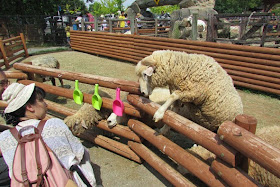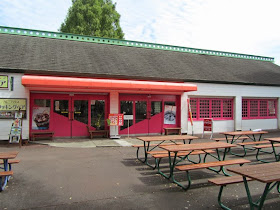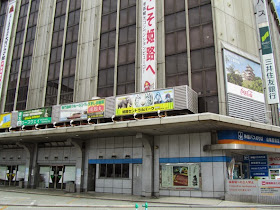Himeji Central Park, opened in 1984, is tucked among a number of small mountains just outside of
Like other “safari parks”, Himeji Central features a “Drive-through Safari” area in which visitors can either drive through in their own cars or ride the park’s bus, and a “Walking Safari” area. The drive-through is composed of three zones: the “Fierce Animals Zone”, the “Herbivorous Animals Zone”, and the “Large Herbivorous Animals Zone”. The “Drive-through Safari” is not really conducive to taking photographs, and it is not satisfying for visitors who want to take a good long look at each of the animals that are kept only in this part of the park. (Tigers, lions, hippopotamus, Bactrian camel, etc.)
If you ride the park’s bus, the experience somewhat resembles a pre-programmed theme park ride. The bus features a recorded presentation explaining the animals in each section, and the vehicle proceeds basically non-stop through each animal zone so quickly that it is a challenge to even spot where the animals are, much less focus your camera and snap a few frames. The brochure states that the ride will take approximately 40 minutes. The first time I visited this park on a not-so-crowded day in 2012, the ride took only 30 minutes. The second time I visited on a very crowded last day of a 3-day weekend in 2014, the long line of cars created a traffic jam. The bus driver might have felt pressured to keep the flow of cars moving because the ride was finished in less than 25 minutes. Even visitors who drive their own cars do not have the liberty of parking in front of their favorite animal. A controller sitting in a watch tower uses the public address system to direct cars to keep the line moving.
Fierce Animals Zone
There
are 3 sections in this zone (cheetahs, lions, and tigers) with double-gated
security entries between each section.
When working properly, one or two vehicles are allowed past the first
gate which then closes behind them. Only
after the first gate is closed will the second gate open to allow the cars entry
into the section where the animal resides.
The double gate on a very crowded day in 2014:
With
the bumper-to-bumper traffic, I had doubts as to whether the gates were being
properly closed between each set of cars.
Below is a photo of the traffic
jam driving past the tiger.
Cheetah
section.
The
lion section.
Tiger
section.
Visitors
should be forewarned that riding the park’s bus requires the purchase of an 800
yen ticket which is separate from the park entry fee, and that tickets for the
limited seats on the bus are distributed on a first-come-first-served basis. The bus departs from the amusement park area
at fixed times, and since the only way to get to the “Walking Safari” area is
to ride the bus, it is advisable to go straight to the bus ticket booth as soon
as you enter the park. On my 2014 visit,
we entered the park only a few minutes after the gates opened at 10:00a.m., yet
we were still unable to get seats for the first two safari buses that departed
at 10:30a.m. Consequently, we had to
wait until the 11:30a.m. buses, and we ended up wasting almost a whole hour. Since I could see 3 unused park buses in the
parking lot, I don’t know why the park couldn’t assign an additional bus to accommodate
the long line of visitors who entered the park at 10:00a.m.
Herbivorous Animals
Zone and Large Herbivorous Animals Zone
The herbivorous animals zone
is basically a mixed species exhibit with deer, ostriches, sheep, and other
herbivores. The animals here appeared to
be well fed and in calm disposition. In the large herbivorous animals zone,
there were rhinoceroses and African elephants.
The Walking Safari
After
completing the drive-through safari, visitors either park their cars or get off
the bus to enjoy the “walking safari”.
This part of the facility emphasizes opportunities for visitors to get
very close to, and to interact with, the resident animals. Depending on your way of thinking, these interactions
in the form of feeding, touching, and photo opportunities either make for a
unique and memorable time with the animals, or are accidents waiting to happen.
I’ll discuss each section of the walking safari in the order that they are usually
experienced by visitors.
Child’s Farm
This
section features what could be best characterized as pets and farm
animals. There were dogs, sheep, goats,
ducks, owls, guinea pigs, rabbits, and even a pony ride. The park’s English
language brochure specifically promotes this zone as a place “where you can
touch animals”, and you can also buy feed to lure the animals closer. Next to almost
all of the animals’ enclosures, there were coin-operated food dispensers or
bowls of food with a money collection box.
This
machine sold wafers filled with pellets for the sheep: 200 yen. The sheep aggressively reach for the food as
you offer it in a plastic scoop.
The
bowls in the below photo contain vegetables for the goats. Visitors are asked to place 200 yen in the
brown wooden box under an honor system.
And although zoo staff do not monitor these transactions, visitors
dutifully comply.
You
can also feed the ducks.
The
sign on this cage warns that the rabbits might bite.
Patagonian
cavys.
Guinea
pigs.
This Harris hawk had only about 2 meters by 2 meters by 2 meters of space. (Not much room for flying.)
Similarly,
at the monkey exhibit next door, a coin-operated machine dispensed food for the
macaques.
This
macaque appears to be eating a little too well.
Flying Cage
For me, the most interesting enclosure
was the “Flying Cage”, an area covered with a giant net roof about 60 or 70
meters long and about 20 meters high at its tallest point. This area featured free roaming capybaras,
ring-tailed lemurs, squirrel monkeys, flamingos, scarlet macaws, blue and
yellow macaws, and a number of waterbirds. The animals in this area were quite
accustomed to the presence of humans, some approaching within 1 or 2 meters of
the visitors.
The
capybaras especially appeared to be accustomed to human contact.
This
young capybara approached the visitors, apparently anticipating that the humans
would soon be carrying fresh green leaves.
A
zookeeper made a short presentation about the capybaras, distributed branches
and leaves to be given to them, and further encouraged the children to touch
the capybaras’ fur. At least from
outward appearances, the animals didn’t seem to be disturbed by the close
presence of the large number of excited children and parents, and they didn’t
seem to particularly mind being touched.
However
the capybaras felt, the whole situation seemed a bit out of control with adults
jostling for positions to take photos of their small children squeezing in to
approach the animals. Even assuming that
the capybaras might not have minded the chaotic crowd, I thought that this
feeding/touching free-for-all could have, or should have, been more closely
supervised. The use of a single-file
line would have allowed the zoo staff to better monitor each visitor’s contact
with the animals to insure safety of the visitors and the animals. Adoption of a minimum distance between the
visitors and the animals during the presentation might have also been a good
idea.
Continuing
on to the second section of the Flying Cage, there was an exhibit of
Meerkats. The animals seemed to be engrossed
in digging holes, and there seemed to be enough space for them to dig naturally
in real dirt. Interestingly, whenever a new
group of visitors approached this exhibit, at least some of the meerkats would
stop what they were doing and approach the fence to look at the people. They seemed to be waiting for some type of food
handout.
I
thought it was unfortunate that there was only a small nameplate at this
exhibit but no explanatory signboards. According
to the park’s brochure, the minimal number of signs in the park is to “keep it
as natural as possible”, and visitors are instructed to refer to the park
brochure. But since the Japanese language brochure contains only minimal
information about the animals (the English language brochure was worst – it only
had the animal names), and because there weren’t any zookeepers around to
answer questions, it seemed like a wasted educational opportunity.
Kangaroo Square
This
area contained 2 kangaroos, 1 emu, and about 8 Bennett’s wallabies. Throughout this area, there were signs in
Japanese asking visitors to stay within the marked walkways.
As can
be seen in the photos below, many visitors ignored the signs to approach and
even touch the animals.
Although
the animals in this area, like the capybaras in the Flying Cage, seemed to be
very accustomed to the close proximity of many humans, I wondered why there
weren’t any zookeepers stationed in this section to monitor the visitors and animals. Allowing small children to stand within
centimeters of a full-grown kangaroo doesn’t seem like a very safe idea.
This section was basically a
feeding area for the African elephants. Almost all of the visitors who stopped here fed
the elephants.
Wafers
filled with pellets were available for 200 yen.
A
zookeeper later came to sell little buckets of carrots and bread for 500 yen.
Savanna Terrace
Another
feeding area: small cups with a few blades of grass and carrot strips were
available on an honor system basis for 200 yen.
Visitors placed the coins in a metal box decorated to look like a
giraffe. The giraffes cleaned out the
contents of these cups with a single flick of the tongue.
An Obsession with
White Animals
One
very noticeable aspect of Himeji Central was its prominent use of white tigers
and white lions to attract visitors. A
large billboard facing the JR Himeji train station features a large face of a
white tiger. The park’s home page
featured many images of white tigers and white lions.
The
keeping of white tigers and white lions is very controversial among zoos in the
United States and in the United Kingdom
This is the white tiger
exhibit. Resembling a department store
display window, it appears to be about 20 meters from left to right and about 4
meters from front to back. It has a
concrete floor and a small pool about the size of a Jacuzzi. I do not recall seeing any living plants
within the exhibit.
Nearby,
visitors could feed meat chunks to the white lions. This activity was limited to the first 30
groups (families or couples) in line, and cost 500 yen to give the lions 4
pieces of meat. A similar feeding was
conducted with the white tigers.
The
photo below shows the exhibit for two white lion cubs, Raimu and Shiel, that
were born July 17, 2014.
For
1000 yen, visitors could take a group photo with the white lion cubs, with up
to 8 people per group. Photo times were
11:00 to 12:00, 13:00 to 14:00, and 15:30 to 16:00, with the number of groups
limited by the time or the condition of the lions. (In the United States
There
were also many white tiger and white lion goods for sale closeby.
There
were even soda vending machines decorated with white lions and white tigers.
Educational Efforts
In addition to the capybara
explanation in the Flying Cage that was mentioned earlier, I also witnessed a
demonstration featuring an owl at the Child’s Farm. I thought that the young
zookeeper conducting this activity did a good job of explaining the owl’s
physical features such as the special construction of its wings which allow it
to fly so silently.
Also
as mentioned earlier, there were few explanatory signs: this zoo appeared to be
heavily skewed to recreation and entertainment.
Food and Souvenirs
There
was an outdoor snack bar next to the Child’s Farm and also four restaurants in
the amusement park. While waiting for
the 11:30a.m. bus into the safari park, we had an early lunch at the “Cooking
Bear” curry restaurant. Since it was
still 10:30a.m., we were the first customers of the day.
Curry
rice and a coca-cola: 1060 yen.
There
was a very large souvenir shop located next to the amusement park exit. It had many types of toys, souvenirs, and
food - and many, many, white tiger/white lion-themed goods.
Getting There
The nearest train station is
the JR Himeji Station, the same station where one gets off to walk to the world
famous Himeji Castle
Inside
of the bus terminal, go to the window and purchase a ticket for “Himeji Sentora-ru
Pa
(Note:
Photos used in this post were taken during visits on June 2, 2012 and September
15, 2014. The comments in this post are
based on observations made on those days.
Conditions may have since changed.
Please check it out for yourself!)























































































